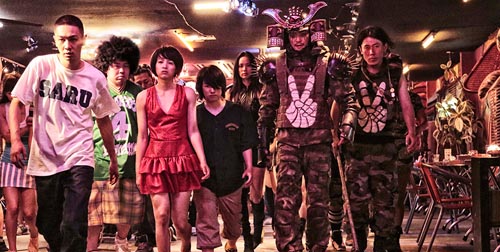 Complex Costumes & Musical Masks
Complex Costumes & Musical Masks
Sion Sono's Tokyo Tribe
published in Film Comment Vol.51 No.3, New York 2015While discos and clubs worship the power of loud bass beats, cinema has long sought to suppress such an aural uprising. It took a wild card like Dennis Hopper to allow Gary Rydstrom’s sound design to blast Ice-T’s 808 kick-boom into the Dolby-SR mix of Colors in 1988. Focussed on racial issues and territorial divisions, Colors is a landmark in allowing the soundtrack to be fat, compressed, and loud—just like rap producers who mixed their beats to sound like gunfire, not drums. That booming bass reverberates a quarter century later in Sion Sono’s Tokyo Tribe (2014), which is basically West Side Story remade as a rap movie. Minus the love story. Hardly any dialogue. Non-stop Hip-Hop. All in Japanese. Its soundtrack—100 percent Japan but sounding straight out of Compton/Brooklyn, and mixed for a nightclub, not a movie theatre —establishes the film as an enticingly aberrant form of transcultural cinema.
Tokyo Tribe’s artifice is key to its audiovisual substance. Facing the Orient, the film’s deft video clip scenography recalls the stagey blackmarket settings in Seijun Suzuki’s 1966 tale of post-war prostitution, Gate Of Flesh, in which a garish broadsheet of sexy Technicolor noir plastered onto a bombed-out Tokyo bizarrely conjures the outdoor staging of Robert Wise’s West Side Story in tenement slums: in both, reality is evident at the edges of the action, but theatrics reign supreme. Sono’s re-imagined Tokyo run by youth gangs and psychopathic yakuza loops West Side Story back to Gate Of Flesh to form a break-beat that underpins Tokyo Tribe’s audiovisual momentum. Indeed, the film is as much 'cut and mixed' in the musical sense as it is directed.
While it plays out a potboiler gangster double-crossing kidnap plot, there’s something wonderfully contra-cinematic in the film’s bombast. With its relentless beats, sonic assault, choreographed break-fu, and the heightened plasticity of its set design, costumes, props and actual rap performers, it’s a truly exhausting movie experience that stands at the limits of cinema. Facing the Occident, Tokyo Tribe also rewrites Walter Hill’s The Warriors—a cinesonic icon in the mythology of Hip Hop whose vision of a multi-racial coalition of gangs aiming to rule New York. Tokyo Tribe audits how hip hop hears cinema, and plays it back, only louder.
This is completely in synch with the film’s source, a 1993 manga by Santa Inoue. Inoue burst onto the manga scene with a story saturated in American Hip Hop references, yet grounded in a Japanese dystopian projection of Tokyo wherein youth runs rampant and controls the streets while waging gang wars over turf. Inoue’s scenario cannily cross-wired Japan’s post-war black markets with debauched Bubble-era nightclubs, both of which fetishised ‘blackness’ in music from America, and aligned it with Japan’s then-burgeoning take on rap and fashion. Just as late Eighties so-called gangster rap looked back to Seventies Blaxploitation cinema as a simulacrum of social woes, Inoue’s Tokyo Tribe riffed on Japan’s own problematic postwar history of illicit commerce and underworld power struggles.
The Japanese context is just as crucial to Sion’s film. It eschews Ozu’s pre-war sentimentality and Kurosawa’s historical mythology for something traditionalist Nippophiles forever bemoan: the Americanization of Japan. But this is precisely the film’s point: with postwar Japan reborn as a cultural chimera, the bulk of its pop culture is deliberately laden with contradictory signage. And just as gangster rap was misread by a conservative white America, so is Japanese pop culture misinterpreted by Nippophiles, especially when it is dressed in offensive non-traditionalist attire. Which is why Tokyo Tribe is loudly decked in Hip Hop: it adorns itself with a myriad of classic musical sub-genres, aligning each with its various gangs, each named after youth hangouts in North-Eastern Tokyo—among them, Shinjuku Hands, Koenji Jacks, Nerimuthafuckas, Musashino Monkeys. Amidst the minefield of styles put together by producer Jashwon for the film, we hear Miami Booty gurgling sub-bass and skull-cracking snares; crate-dug sample loops of tom-toms, autoharp and wah guitar; Ravey synth arpeggios and dope-hazed Electro beats; one-note orchestra bursts over raw 808 drums. Japan is renowned for its record collectors, and the film’s endless tracks create an affective headspace which sonically maps the labyrinthine mythology of globalised Hip Hop. While the rest of the world might find Japanese Hip Hop laughable, its complex costumery and musical mask-making accords with a surface sensibility which ends up being uniquely Japanese. You can hear it in Tokyo Tribe.
Text © Philip Brophy 2015. Images © XLrator

